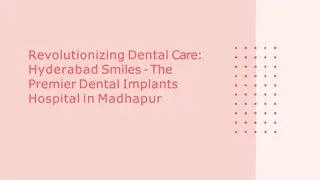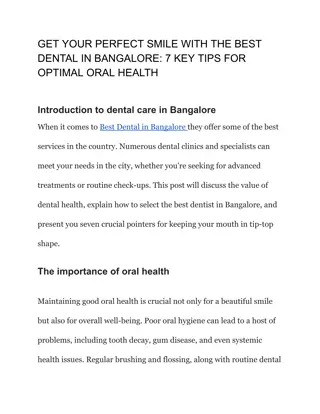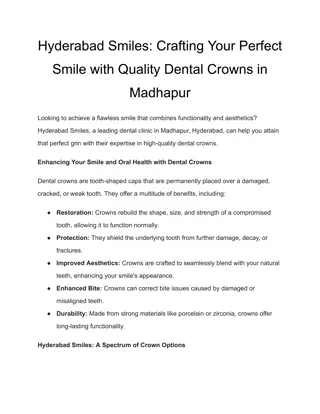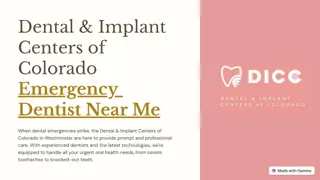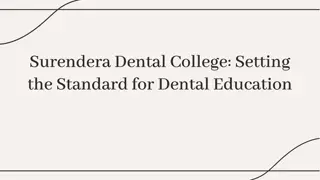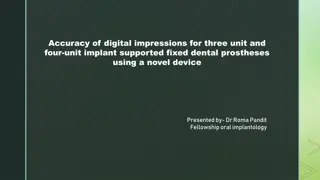The Taking of Dental Impressions Training Course
The Taking of Dental Impressions Training Course, provided by the BOS, equips registered Dental nurses with the necessary knowledge and skills for taking dental impressions. The course covers scientific/clinical knowledge, practical skills, patient care, and communication. Successful completion leads to a certificate of achievement with 10 CPD hours. The course also includes a record of experience component.
Download Presentation

Please find below an Image/Link to download the presentation.
The content on the website is provided AS IS for your information and personal use only. It may not be sold, licensed, or shared on other websites without obtaining consent from the author.If you encounter any issues during the download, it is possible that the publisher has removed the file from their server.
You are allowed to download the files provided on this website for personal or commercial use, subject to the condition that they are used lawfully. All files are the property of their respective owners.
The content on the website is provided AS IS for your information and personal use only. It may not be sold, licensed, or shared on other websites without obtaining consent from the author.
E N D
Presentation Transcript
The Taking of Dental Impressions Is A training course set up by the BOS to provide qualified and registered Dental nurses with the knowledge and skills needed to take dental impressions
The Course will provide the student: with scientific/clinical knowledge and an understanding of the taking of dental impressions. with the practical skills needed. with the management of patient care and communication.
The course will provide Aims and Objectives through lectures and presentations Demonstration and practical skills Learning Outcomes
Aims and Objectives Aims To provide knowledge and understanding required for the taking of impressions within a clinical environment To provide practical skills required in the taking of impressions within the dental environment To provide skills in the management of patient care and communication
Objectives To have the knowledge and understanding required to carry out the taking of impressions within the dental environment To be competent in the practical skills required in the taking of dental impressions To be competent in the management of patient care and communication
Once the student is considered competent and a record of experience has been completed and assessed, a certificate of achievement will be issued with 10 verifiable CPD hours
Record of Experience The student will need to complete a record of experience which will need to be assessed by the course provider. The log sheets will contain: 10 observations of the taking of dental impressions with clinical instruction 20 supervised taking of dental impressions with clinical support 20 unsupervised taking of dental impressions with clinical support . Five of these must be taken of an adult
The Syllabus The provision of scientific/clinical knowledge of the taking of dental impressions Procedures involved in the taking of dental impressions within a clinical environment Communication within the dental environment Legislation and Health and Safety guidelines controlling the taking of dental impressions
Scientific/clinical Knowledge This will be provided by the Dental clinicians at Mid-Wessex Orthodontics and the supporting Dental Care Professional Team This will be provided in the form of lectures, presentation and practical demonstration.
Clinical Procedures At the end of this unit the dental nurse will: Be competent in the correct selection of dental biomaterials Be competent in the correct manipulation and safe handling of dental biomaterials Have knowledge and understanding of the science and limitations of dental biomaterials Be competent in the selection of impression trays and be aware of their advantages and disadvantages Be competent in the taking of accurate dental impressions
Communication At the end of this unit the dental nurse will: Be able to demonstrate excellent communication skills with patients, their families and carers, other members of the dental team and other health care professionals Be able to demonstrate empathy and manage patients from different social/ethnic background and those with additional needs/special care requirements Be familiar with the manifestations of anxiety and pain and be able to demonstrate method of management and control
Health and Safety and Legislation At the end of this unit the dental nurse will: Be competent in the implementation of excellent infection control, preventing the physical, chemical and microbiological contamination in the clinical area and laboratory (where applicable) Be competent in the correct disinfection of dental impressions Be knowledgeable in the responsibilities of consent Be competent in the implementation of medical emergencies and how to respond to them
Scientific Knowledge and Clinical Procedures Dental Impression Materials
Aims and Objectives Aims To provide scientific knowledge of dental impression materials to enable correct selection of appropriate materials To provide knowledge to enable the taking of dental impressions Objectives To have the scientific knowledge for the correct selection of appropriate materials and the ability to take dental impressions
Dental Impressions Dental impressions are taken of the patients oral structures to form a mould that has negative dimensions The mould is then cast using a dental gypsum product to form a positive model of the physical dimensions, shapes and spatial relationships of these structures
Materials used for the taking of impressions is mixed (using manufacturers instructions) to form A preparation in a low viscosity state that is placed and formed against the oral structures Significant increase in the viscosity of the material occurs The preparation is then removed from the patient s mouth Increase in viscosity happens due to physical changes in temperature or a chemical reaction to the properties of the preparation
Changes in the properties of the preparation The combination of the properties before, during and after the setting of the preparation determines the suitability of the impression material for each clinical situation
Dental Impressions There are different types of impression material used in dentistry and are determined by the clinical procedure Those with minimal elastic deformation after setting Those that undergo significant elastic deformation required to remove the material after setting.
Dental impression materials Impression compounds Elastics- hydrocolloids Elastics-Silicones/polyethers Polysulphides
Impression Compounds These are mainly rigid impression materials that set by physical change Red, green or brown stick compound Zinc oxide paste with eugenol Dental gypsum (impression plaster)
Impression Compounds These compounds are still used occasionally in the surgery but are most likely to be used in the dental laboratory. They have poor dimensional stability and are messy to use.
Elastics-Hydrocolloids These dental impression materials are used frequently both in the surgery and the laboratory. There are two types: Reversible hydrocolloid- Agar Irreversible hydrocolloid- Alginate
Agar- used for duplicating study models and working models usually in the laboratory. The material can be reused. Alginate- used for study models, orthodontic study models, working models for first stage of prosthesis, orthodontic appliances, corresponding dental arches for crown and bridge work, mouth-guards. This material cannot be reused
Alginate Advantages Easy to prepare and mix- powder and water, sets by chemical reaction Easy to manipulate and form around oral structures Reasonable dimensional stability Economic Disadvantages Can shrink and distort if not submerged in disinfection solution before casting Can absorb solution if left submerged for too long causing it to distort Can tear easily It is not suitable for more complex and detailed dental work such as crown and bridge work, chrome cobalt partial dentures and some orthodontic appliances (Invisalign, lingual fixed appliance)
Alginate Powder Consists of Potassium alginate or sodium alginate and calcium hydrate they react together to form calcium alginate gel which is insoluble in water. Sodium alginate is derived from seaweed The material is viscoelastic and is the principal component of the impression material It also contains a substantial amount of filler, disinfectant, setting time modifiers and chemicals to counteract the inhibiting effects of the material on contact with dental gypsum It also contains glycol which prevents the small powder particles from being inhaled during dispensing
Preparation, mixing and handling of alginate As registered and qualified dental nurses you are aware of the correct procedures in the preparation, mixing and handling of alginate and this will be revised during the practical demonstrations
Characteristics of alginate There is little dimensional change during setting There is optimal resistance to plastic deformation when removing from the patients mouth However, it can tear when removing if there are obstacles such as the presence of fixed orthodontic appliance, failing restorations, undercuts or the presence of a fixed or removable prosthesis
Properties of Alginate After setting, water is easily exchanged into or out of the gel which can affect dimensional accuracy, therefore casting as soon as possible is advised. If left to dry out, it will shrink and if left in disinfectant solution for too long it will absorb water and distort
Elastics-Polyethers and silicones are: Rubber like synthetic material formed by chemical reaction Polysulphides are not often used and so will not be discussed further on this course
Polyethers and silicones These impression materials require a: Base Catalyst Equal parts of these are mixed thoroughly together. They are manipulated and formed around the oral structures, a chemical reaction takes place and the preparation sets.
Polyethers and silicones These preparations have different properties and can be Light body- used as a wash for fine detailing for crowns, bridges, inlays, veneers, invisalign Medium body- can be used for relining dentures, chrome cobalt partial dentures Heavy body- used for the negative mould of the oral structures and a carrier for the light/medium body elastics/elastomers
Polyethers and silicones Advantages Excellent dimensional stability Good detailing Easy to mix and manipulate Does not tear Disadvantages Expensive Cannot be mixed using latex gloves (nitrile gloves are recommended)
The Taking of Dental impressions The instruction of the taking of dental impressions is a practical lesson and will be carried out in the surgery. Alginate impression material will be used for the practical. Information sheets will be available at this session.
Aims and Objectives Aims To provide knowledge to enable excellent communication skills with patients, their families and carers, other members of the dental team and other health care professionals To provide knowledge to enable empathy and manage patients from different social/ethnic background and those with additional needs/special care requirements To provide knowledge to manage the manifestations of patient anxiety and pain and to demonstrate method of management and control
Objectives To have the knowledge to enable excellent communication skills with patients, their families and carers, other members of the dental team and other health care professionals To have the knowledge to enable empathy and manage patients from different social/ethnic background and those with additional needs/special care requirements To have the knowledge to manage the manifestations of patient anxiety and pain and to demonstrate method of management and control
Communication It is always important to consider the patient, their accompanying family members and carers. As a DCP always- Be polite and courteous Use positive reinforcement in your language and refrain from using dental jargon Use positive and open body language Explain the procedure Gain consent
The ability : To use active listening skills To have open body language To gather and impart information effectively To handle patient s emotions sensitively To demonstrate, empathy, rapport, social and ethical awareness To be professional
Benefits: Increased patient satisfaction Decreased patient anxiety Improved patient co-operation to dental recommendations Lower rates of formal complaints and malpractice claims
In 1990, the inclusion of teaching behavioural science in dental schools was published in the General Dental Council guidelines
It was recommended that communication skills were taught to include: Interpersonal skills Practical based learning such as role play and clinical relevant scenarios Self assessment and evaluation Small groups for optimal learning
The Calgary-Cambridge Concept (CCOG) is An evidence based approach to cover the content and serve as an organisational guideline Recommended as being one of the most comprehensive and useful frameworks for instruction of communicational skills It is judged as the communication guideline of the highest quality It integrates the social and technical processes typical in the dental world
The Calgary-Cambridge Concept (CCOG) covers many aspects that you as qualified and registered Dental nurses have been trained in and are aware of such as Introduction Explanation, procedure, importance of consent Body language, facial expressions, emotion Listening skills
Communication Consent It is always important to gain consent before continuing with any procedure Implied consent- the patient gives consent by sitting in the dental chair and opens their mouth Informed consent- the procedure is explained and the patient verbally consents to proceed Written consent- the patient or their parent/guardian reads a document with the procedure clearly explained and signs to confirm they are happy to continue
Communication Anxiety Control
Aims To become familiar in the manifestations of anxiety and the various methods of management and control To develop theoretical, practical and clinical skills to manage fear and anxiety using behaviour techniques and empathy with patients in stressful situations Objectives Be familiar with the manifestations of anxiety and the various methods of management and control Be competent in the management of fear and anxiety using behavioural techniques and empathy to support patients in stressful situations










